Kazushi Tsutsui
Runner re-identification from single-view video in the open-world setting
Oct 18, 2023Abstract:In many sports, player re-identification is crucial for automatic video processing and analysis. However, most of the current studies on player re-identification in multi- or single-view sports videos focus on re-identification in the closed-world setting using labeled image dataset, and player re-identification in the open-world setting for automatic video analysis is not well developed. In this paper, we propose a runner re-identification system that directly processes single-view video to address the open-world setting. In the open-world setting, we cannot use labeled dataset and have to process video directly. The proposed system automatically processes raw video as input to identify runners, and it can identify runners even when they are framed out multiple times. For the automatic processing, we first detect the runners in the video using the pre-trained YOLOv8 and the fine-tuned EfficientNet. We then track the runners using ByteTrack and detect their shoes with the fine-tuned YOLOv8. Finally, we extract the image features of the runners using an unsupervised method using the gated recurrent unit autoencoder model. To improve the accuracy of runner re-identification, we use dynamic features of running sequence images. We evaluated the system on a running practice video dataset and showed that the proposed method identified runners with higher accuracy than one of the state-of-the-art models in unsupervised re-identification. We also showed that our unsupervised running dynamic feature extractor was effective for runner re-identification. Our runner re-identification system can be useful for the automatic analysis of running videos.
Action valuation of on- and off-ball soccer players based on multi-agent deep reinforcement learning
May 29, 2023



Abstract:Analysis of invasive sports such as soccer is challenging because the game situation changes continuously in time and space, and multiple agents individually recognize the game situation and make decisions. Previous studies using deep reinforcement learning have often considered teams as a single agent and valued the teams and players who hold the ball in each discrete event. Then it was challenging to value the actions of multiple players, including players far from the ball, in a spatiotemporally continuous state space. In this paper, we propose a method of valuing possible actions for on- and off-ball soccer players in a single holistic framework based on multi-agent deep reinforcement learning. We consider a discrete action space in a continuous state space that mimics that of Google research football and leverages supervised learning for actions in reinforcement learning. In the experiment, we analyzed the relationships with conventional indicators, season goals, and game ratings by experts, and showed the effectiveness of the proposed method. Our approach can assess how multiple players move continuously throughout the game, which is difficult to be discretized or labeled but vital for teamwork, scouting, and fan engagement.
Adaptive action supervision in reinforcement learning from real-world multi-agent demonstrations
May 22, 2023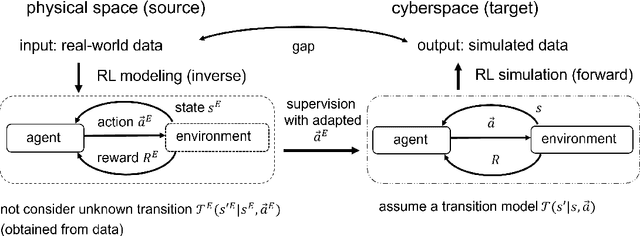
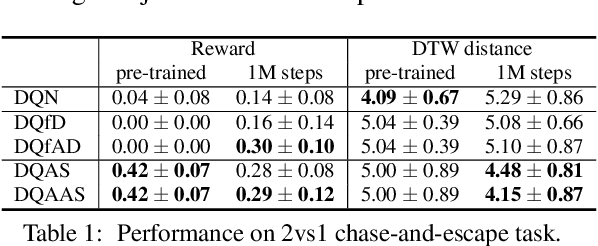


Abstract:Modeling of real-world biological multi-agents is a fundamental problem in various scientific and engineering fields. Reinforcement learning (RL) is a powerful framework to generate flexible and diverse behaviors in cyberspace; however, when modeling real-world biological multi-agents, there is a domain gap between behaviors in the source (i.e., real-world data) and the target (i.e., cyberspace for RL), and the source environment parameters are usually unknown. In this paper, we propose a method for adaptive action supervision in RL from real-world demonstrations in multi-agent scenarios. We adopt an approach that combines RL and supervised learning by selecting actions of demonstrations in RL based on the minimum distance of dynamic time warping for utilizing the information of the unknown source dynamics. This approach can be easily applied to many existing neural network architectures and provide us with an RL model balanced between reproducibility as imitation and generalization ability to obtain rewards in cyberspace. In the experiments, using chase-and-escape and football tasks with the different dynamics between the unknown source and target environments, we show that our approach achieved a balance between the reproducibility and the generalization ability compared with the baselines. In particular, we used the tracking data of professional football players as expert demonstrations in football and show successful performances despite the larger gap between behaviors in the source and target environments than the chase-and-escape task.
Location analysis of players in UEFA EURO 2020 and 2022 using generalized valuation of defense by estimating probabilities
Nov 30, 2022



Abstract:Analyzing defenses in team sports is generally challenging because of the limited event data. Researchers have previously proposed methods to evaluate football team defense by predicting the events of ball gain and being attacked using locations of all players and the ball. However, they did not consider the importance of the events, assumed the perfect observation of all 22 players, and did not fully investigated the influence of the diversity (e.g., nationality and sex). Here, we propose a generalized valuation method of defensive teams by score-scaling the predicted probabilities of the events. Using the open-source location data of all players in broadcast video frames in football games of men's Euro 2020 and women's Euro 2022, we investigated the effect of the number of players on the prediction and validated our approach by analyzing the games. Results show that for the predictions of being attacked, scoring, and conceding, all players' information was not necessary, while that of ball gain required information on three to four offensive and defensive players. With game analyses we explained the excellence in defense of finalist teams in Euro 2020. Our approach might be applicable to location data from broadcast video frames in football games.
Evaluation of creating scoring opportunities for teammates in soccer via trajectory prediction
Jun 04, 2022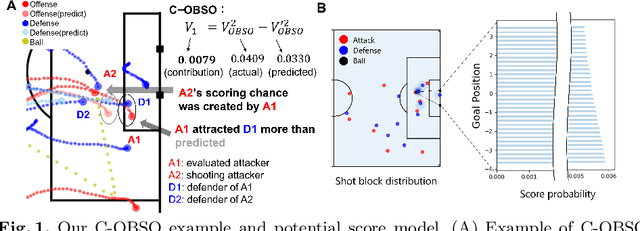



Abstract:Evaluating the individual movements for teammates in soccer players is crucial for assessing teamwork, scouting, and fan engagement. It has been said that players in a 90-min game do not have the ball for about 87 minutes on average. However, it has remained difficult to evaluate an attacking player without receiving the ball, and to reveal how movement contributes to the creation of scoring opportunities for teammates. In this paper, we evaluate players who create off-ball scoring opportunities by comparing actual movements with the reference movements generated via trajectory prediction. First, we predict the trajectories of players using a graph variational recurrent neural network that can accurately model the relationship between players and predict the long-term trajectory. Next, based on the difference in the modified off-ball evaluation index between the actual and the predicted trajectory as a reference, we evaluate how the actual movement contributes to scoring opportunity compared to the predicted movement. For verification, we examined the relationship with the annual salary, the goals, and the rating in the game by experts for all games of a team in a professional soccer league in a year. The results show that the annual salary and the proposed indicator correlated significantly, which could not be explained by the existing indicators and goals. Our results suggest the effectiveness of the proposed method as an indicator for a player without the ball to create a scoring chance for teammates.
Learning interaction rules from multi-animal trajectories via augmented behavioral models
Jul 14, 2021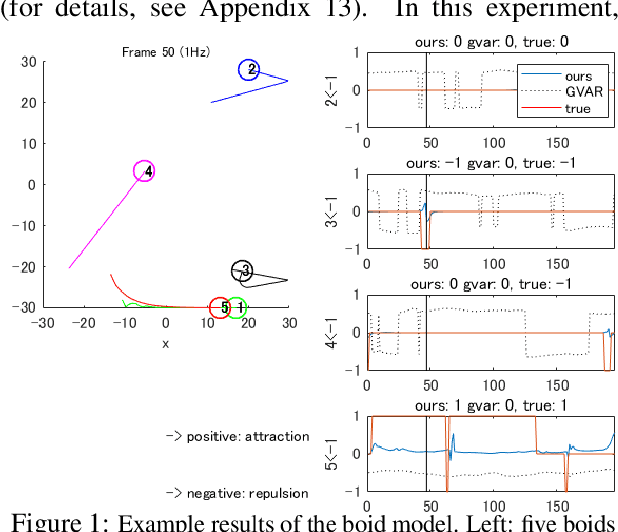
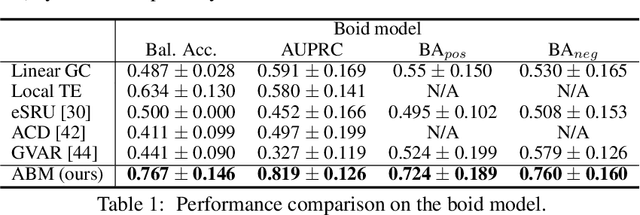
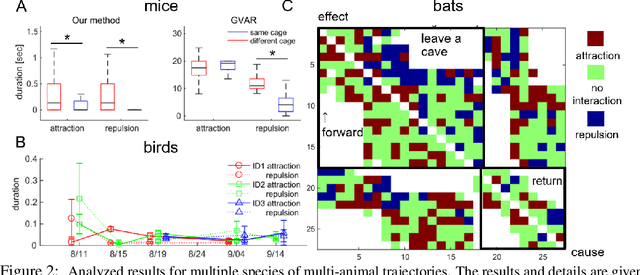
Abstract:Extracting the interaction rules of biological agents from moving sequences pose challenges in various domains. Granger causality is a practical framework for analyzing the interactions from observed time-series data; however, this framework ignores the structures of the generative process in animal behaviors, which may lead to interpretational problems and sometimes erroneous assessments of causality. In this paper, we propose a new framework for learning Granger causality from multi-animal trajectories via augmented theory-based behavioral models with interpretable data-driven models. We adopt an approach for augmenting incomplete multi-agent behavioral models described by time-varying dynamical systems with neural networks. For efficient and interpretable learning, our model leverages theory-based architectures separating navigation and motion processes, and the theory-guided regularization for reliable behavioral modeling. This can provide interpretable signs of Granger-causal effects over time, i.e., when specific others cause the approach or separation. In experiments using synthetic datasets, our method achieved better performance than various baselines. We then analyzed multi-animal datasets of mice, flies, birds, and bats, which verified our method and obtained novel biological insights.
 Add to Chrome
Add to Chrome Add to Firefox
Add to Firefox Add to Edge
Add to Edge